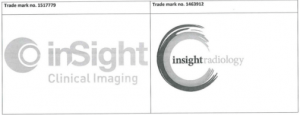In the case of Pham Global Pty Ltd v Insight Clinical Imaging Pty Ltd [2017] FCAFC 83, Mr Pham filed a trade mark application for the trade mark on the right below (IR Trade Mark). This application was opposed by the owner of the trade mark on the left, Insight Clinical Imaging (Clinical Imaging):

Mr Pham’s intention
Mr Pham was a director of the company eventually known as Pham Global. Mr Pham, using his company email, arranged for the design of the IR Trade Mark. He gave evidence in the case that he intended to license his company to use the IR Trade Mark. However, there was never any written licence agreement and the trial judge did not believe him. Instead the trial judge found that Mr Pham never intended to use the IR Trade Mark himself, including by licensing his company, but rather he always intended his company to use the IR Trade Mark in connection with its radiology business.
This may not sound like a big difference but it meant that Insight Clinical succeeded in establishing that the trade mark applicant, Mr Pham, was not the owner of the IR Trade Mark, which is a ground on which a trade mark application can be successfully opposed and the application rejected. The IR Trade Mark application had been made in the wrong name. It should not have been in the name of Mr Pham but in the name of his company.
Trade mark ownership
For someone to own a trade mark either:
- For a trade mark already in use – the trade mark applicant must have first adopted and used the trade mark; or
- For a trade mark not yet in use – the trade mark applicant must have first adopted the trade mark, filed the application and intended to use the trade mark itself or license someone else to do so.
Assignment does not cure a defect in ownership
Mr Pham did assign the IR Trade Mark application to his company Pham Global. According to previous case law, this would have been sufficient to cure the defect in ownership because the application was in the right name before the trade mark was registered. However the Court in Pham Global overruled this earlier case law, thus changing the law regarding ownership of a trade mark application. The Court held that an application must be made in the name of the true owner and a later assignment to the true owner cannot correct any defect in ownership. The application will be invalid.
The trial judge commented that Mr Pham did not pay much regard to the corporate structures under which his business activities were carried out, and suggested that Mr Pham filed the trade mark application without really thinking about whether he had the right to do so.
Take home message
This is a trap that other companies could easily fall into. It is important to think about who will use the trade mark. If a company will use the trade mark, generally speaking, it is best to file the application in the company’s name unless there is a good reason not to. One good reason not to is if it is intended that all trade marks be held in the name of a holding company that licenses the use of the trade marks to its subsidiaries. This is a strategy that can be used to protect the IP assets in the event of liquidation of a subsidiary. In this case, preferably, there should be a written licence agreement between the trade mark owner and the company using the trade mark.
In the case of proprietary companies with, perhaps, a sole director and shareholder, putting the trade mark application in the name of this person may seem sensible and achieve a similar aim to putting the assets in the name of a holding company. However, it is important to document this arrangement or the trade mark application may be found to be invalid as in the case of Pham Global.
